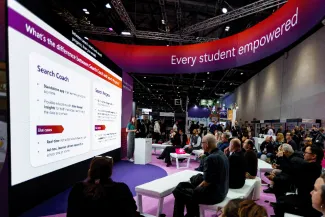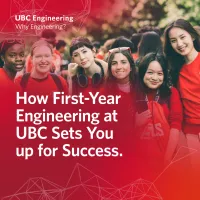"The work terms and coursework I completed over my undergraduate degree gave me a strong technical foundation, and I feel like my engineering physics background has helped me quickly pick up new disciplines."

Emma Gray
- Degree:
- Bachelor of Applied Science
- Grad year: 2022
- Program:
- Campus: Vancouver
Job: Product Manager at Microsoft
Tell us about your job at Microsoft.
I’m a Product Manager on Microsoft’s Education Product team working on Learning Accelerators, free tools that empower learners while freeing up time for educators to focus on what matters most. Many people describe product management as a role that operates at the intersection of technology, business and user experience design.
My job requires me to develop a deep understanding of our customer base so I can represent the voices of students, teachers and school administrators to our teams at Microsoft.
I then work with our design, engineering and research teams (and other experts) to define the problem space, the opportunity within it, and what we should build in response. I work iteratively with our technical teams and designers, while checking back with our customers, to make sure that what we’re building truly addresses the problem at hand. It’s the whole APSC 100 engineering design process in action!
Beyond the product work, I’ve also had the chance to travel all over the place, presenting our education tools and speaking about AI at conferences in Canada and internationally in the UK and across the US.
Microsoft is doing some very exciting and innovative new things in the AI education space, including partnering with Khan Academy to develop cutting-edge AI models for math tutoring. It’s a super exciting time to be here!
Microsoft’s Education Product team Learning Accelerators
APSC 100 Partnering with Khan Academy

It sounds like a very interdisciplinary environment.
You bet. A single day might be spent talking with designers, engineers, marketers, researchers, ninth graders, teachers and other product managers.
My job requires me to use my engineering skills to ground abstract needs with the reality of what’s actually possible, and to be able to “context switch” and speak the language of many disciplines.
The work terms and coursework I completed over my undergraduate degree gave me a strong technical foundation, and I feel like my engineering physics background has helped me quickly pick up new disciplines. That’s been important, because having a conversational level of competency across the disciplines that I overlap with helps me to ask better questions and propose better solutions.
I love the multidisciplinary nature of my work, of being able to sketch out an idea to send to a designer, mock up a business plan for product marketing managers or propose an adaptive learning algorithm to the engineering team for Math Coach.

How did you choose Engineering Physics?
I was grateful for UBC Engineering’s general first year, which gives you a chance to almost “speed date” each of the engineering disciplines offered.
I actually started off in Integrated Engineering because I liked its multidisciplinary nature – I am a generalist by nature, and the openness of the discipline appealed to me.
However, after a year I transferred to Engineering Physics because I wanted more of a software focus and greater freedom with my electives. I was getting quite interested in business and I wanted to take some business electives as well. Courses on product development, design methods and innovation leadership all helped me to understand how I really wanted to leverage my engineering skills in the product space. I loved them enough that I ended up being a TA for the latter two courses in the last years of my degree.
Foundation year Engineering Physics
Product development course Design methods course

How about extracurriculars?
My first hackathon was definitely memorable – and our team placed first!
During the Robot Summer of 2019 I did a side project through the eatART Foundation, where I brought together my interests in mechatronics and art to design and build a gigantic robotic butterfly with an incredible interdisciplinary team. The piece was part of Vancouver’s Lumiere 2019 festival and also travelled to several festivals throughout the US, including Burning Man.
I was also part of the Biomedical Engineering Student Team, BEST, eventually becoming co-captain and leading a team of more than 90 undergrads.
Gigantic robotic butterfly Lumiere 2019
Any advice for others who are embarking on their studies or a career in engineering?
Be open to the turns in the road; I went in thinking I’d end up as a biomedical engineer, and instead graduated in Engineering Physics with a passion for product management.
I realized what mattered for me most was the ability to build things that help people, and I learned that there are so many ways to do that!
Credit where it’s due – I heard this next one from a fellow panelist at a UBC Women in Data Science panel (another great UBC club!) – whenever you’re presented with a decision point and you’re not sure how to proceed, think about where your passion is and choose the path that you are even just marginally more interested in. Do that again and again, and the decisions can accumulate towards bigger and better things! I didn’t realize it at the time, but this was my approach throughout my time at UBC.
At the end of the day I left with a huge collection of experiences that have informed where I am now, working in a rewarding role with amazing people at a great company, doing something I care deeply about.







